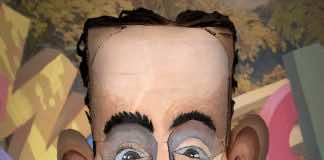
It is hard to convey the many ideas that are packed into the new film by Thom Andersen, an exploration of concepts and experiences acquired and felt through film. In The Thoughts That Once We Had we get to experience the subtle language that is cinema and feel the many ways in which we can be affected by it through the alternative narrative proposed by Andersen. This analytical film provides insight into the more academic frontiers of the medium. The film is based on Andersen’s work and a course he taught in CalArts based on Gilles Deleuze’s writings, Cinema 1: The Movement-Image and Cinema 2: The Time-Image. These are dense readings that break away from the idea of analyzing film from a psychoanalytic or symbolic perspective and give way to a more constructivist take, one which sees the audience as participant and not merely receptive to the filmmaking process.
The disruptive narrative in Thoughts That Once We Had is representative of the ideas developed by Deleuze. He is perhaps better known for developing a distinction between the time-image (those images in film that disrupt the time continuum), and the movement-image (characteristic of those films that have a linear narrative such as a traditional Hollywood film). The time-image is the more contemplative category, the one that conveys thoughts and creates an alternative reality through its existence — a different sort of language. As Andersen shows and unpacks these concepts, we as an audience get a sense of how we let these images into our subconscious, into our lives as part of lived memories that are not only relatable but that also become part of a personal repertoire of images. This might be especially true for cinephiles, like myself.

Thoughts That Once We Had opens these concepts and showcases their intrinsic value through a selection of clips that also feature plenty of quotes from Deleuze. It is a sort of visual essay. The opening sequence explores “affection-image,” a primal way of eliciting emotion from the audience and creating a moment that is shared through that emotion. It does not necessarily require a priori knowledge of a situation. Andersen uses silent film to demonstrate the power of film in creating a connection between the viewer and the subjects on film. One does not need too much contextual explanation when this “affection-image” appears. It takes hold of the audience in a primal way, creating an imagined back story that leads to that emotion.
The textual interventions by Andersen demonstrate a full knowledge and mastery of the concepts developed by Deleuze. What starts as a fairly simple analysis involving emotions develops further into the more complicated “time-image” and the development of sequences in film, wherein thoughts are developed in relation to the sequence of images. The first image can exist by itself, but the second is a result of the first either as an outcome or a force and the third cannot exist without reference to the previous ones. In this sense, sequences develop thoughts. These ideas in turn may develop memories and leave imprints within ourselves. It is a relational analysis in which meaning depends a lot on personal experiences and what the audiences bring to the analysis. Each viewing then represents its own different experience, complete with a separate creation that occurs within ourselves as we experience the film and acquire these images within all the others we collect through a lifetime, constructing memories and realities.

What is the most interesting about this film essay is what film clips Andersen decided to include. In turn and based on Deleuze’s theories, it reveals something about the auteur. The choice of clips and how they are ordered, pairing them with different texts reveals a very intimate portrayal of an academic. Andersen is not only crafting a film that “reads” like a visual essay, he is also baring his own thought process about and on film. If you give this think-piece/visual essay a chance, it is sure to provoke some reassessment about your own personal relationship with those images and sequences on film that you hold so dear.
Thoughts That Once We Had runs 108 minutes and it is not rated. I was able to catch a screening at the National Gallery of Art in Washington D.C. For screenings nationwide click here. Grasshopper Films provided all images used in this post.









